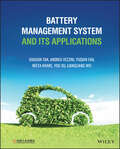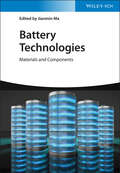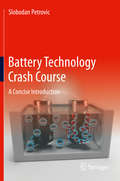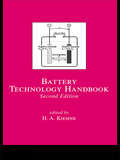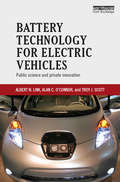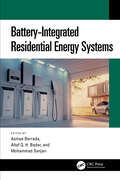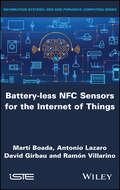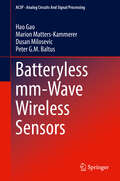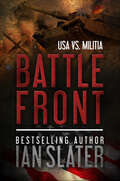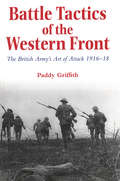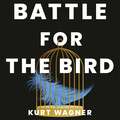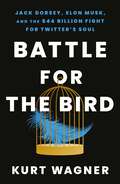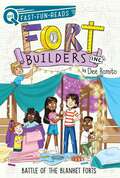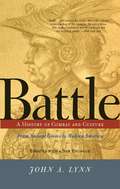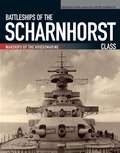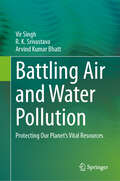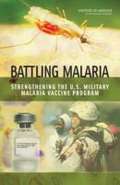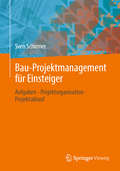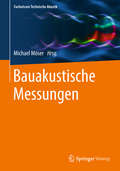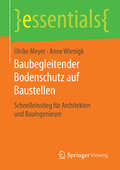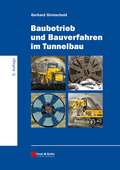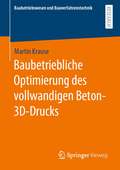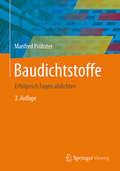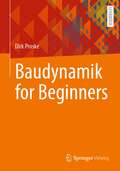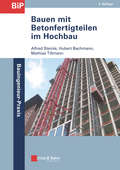- Table View
- List View
Battery Management System and its Applications
by Xiaojun Tan Andrea Vezzini Yuqian Fan Neeta Khare You Xu Liangliang WeiBATTERY MANAGEMENT SYSTEM AND ITS APPLICATIONS Enables readers to understand basic concepts, design, and implementation of battery management systems Battery Management System and its Applications is an all-in-one guide to basic concepts, design, and applications of battery management systems (BMS), featuring industrially relevant case studies with detailed analysis, and providing clear, concise descriptions of performance testing, battery modeling, functions, and topologies of BMS. In Battery Management System and its Applications, readers can expect to find information on: Core and basic concepts of BMS, to help readers establish a foundation of relevant knowledge before more advanced concepts are introduced Performance testing and battery modeling, to help readers fully understand Lithium-ion batteries Basic functions and topologies of BMS, with the aim of guiding readers to design simple BMS themselves Some advanced functions of BMS, drawing from the research achievements of the authors, who have significant experience in cross-industry research Featuring detailed case studies and industrial applications, Battery Management System and its Applications is a must-have resource for researchers and professionals working in energy technologies and power electronics, along with advanced undergraduate/postgraduate students majoring in vehicle engineering, power electronics, and automatic control.
Battery Technologies: Materials and Components
by Jianmin MaBattery Technologies A state-of-the-art exploration of modern battery technology In Battery Technologies: Materials and Components, distinguished researchers Dr. Jianmin Ma delivers a comprehensive and robust overview of battery technology and new and emerging technologies related to lithium, aluminum, dual-ion, flexible, and biodegradable batteries. The book offers practical information on electrode materials, electrolytes, and the construction of battery systems. It also considers potential approaches to some of the primary challenges facing battery designers and manufacturers today. Battery Technologies: Materials and Components provides readers with: A thorough introduction to the lithium-ion battery, including cathode and anode materials, electrolytes, and binders Comprehensive explorations of lithium-oxygen batteries, including battery systems, catalysts, and anodes Practical discussions of redox flow batteries, aqueous batteries, biodegradable batteries, and flexible batteries In-depth examinations of dual-ion batteries, aluminum ion batteries, and zinc-oxygen batteries Perfect for inorganic chemists, materials scientists, and electrochemists, Battery Technologies: Materials and Components will also earn a place in the libraries of catalytic and polymer chemists seeking a one-stop resource on battery technology.
Battery Technology Crash Course: A Concise Introduction
by Slobodan PetrovicThis book is a concise introductory guide to understanding the field of modern batteries, which is fast becoming an important area for applications in renewable energy storage, transportation, and consumer devices. By using simplified classroom-tested methods developed while teaching the subject to engineering students, the author explains in simple language an otherwise complex subject in terms that enable readers to gain a rapid understanding of batteries and the scientific and engineering concepts and principles behind the technology. This powerful tutorial is a great resource for engineers from other disciplines, technicians, analysts, investors, and other busy professionals who need to quickly acquire a solid understanding of the fast emerging and disruptive battery landscape.
Battery Technology Handbook (Electrical Engineering And Electronics Ser. #Vol. 118)
by H.A. KiehneThis practical reference remains the most comprehensive guide to the fundamental theories, techniques, and strategies used for battery operation and design. It includes new and revised chapters focusing on the safety, performance, quality, and enhancement of various batteries and battery systems. From automotive, electrochemical, and high-energy applications to system implementation, selection, and standardization, the Second Edition presents expert discussions on electrochemical energy storage, the advantages of battery-powered traction, the disposal and recycling of used batteries, hazard prevention, and the chemistry and physics of lithium primary batteries.
Battery Technology for Electric Vehicles: Public science and private innovation
by Albert N. Link Alan C. O'Connor Troy J. ScottElectric drive vehicles (EDVs) are seen on American roads in increasing numbers. Related to this market trend and critical for it to increase are improvements in battery technology. Battery Technology for Electric Vehicles examines in detail at the research support from the U.S. Department of Energy (DOE) for the development of nickel-metal-hydride (NiMH) and lithium-ion (Li-ion) batteries used in EDVs. With public support comes accountability of the social outcomes associated with public investments. The book overviews DOE investments in advanced battery technology, documents the adoption of these batteries in EDVs on the road, and calculates the economic benefits associated with these improved technologies. It provides a detailed global evaluation of the net social benefits associated with DOEs investments, the results of the benefit-to-cost ratio of over 3.6-to-1, and the life-cycle approach that allows adopted EDVs to remain on the road over their expected future life, thus generating economic and environmental health benefits into the future.
Battery-Integrated Residential Energy Systems
by Asmae Berrada Badar, Altaf Q. H. Mohammad SanjariBattery-Integrated Residential Energy Systems introduces battery energy storage systems (BESS) of residential systems and offers insight into modeling, managing, and controlling them. Apart from survey of different BESS applications, it explains electrochemical simulation models of BESS. It includes performance parameters, economic analysis, sizing, energy management, control, charging and discharging patterns, coordination of the storage system with other devices in the home, and policy-related matters.Features: Covers different aspects of smart residential energy systems with a battery as a key element Discusses increasing energy efficiency in residential units by optimal control and management of BESS Explores information related to the policy regarding the use of BESS Includes chapters on energy trading for implementation of optimal energy management of BESS Focuses on a variety of aspects of battery operation and control This book is aimed at senior undergraduate, graduate students, and researchers in Electrical Engineering, Battery Systems, Energy Engineering, and Sustainable and Renewable Technologies.
Battery-less NFC Sensors for the Internet of Things
by Martí Boada Antonio Lazaro David Girbau Ramón VillarinoThe implementation of near-field communication (NFC) technology in smartphones has grown rapidly, especially due to the use of this technology as a payment system. In addition, the ability to use the energy transmitted not only for communication, but also for feeding other devices, which together with the low cost of NFC chips and the internet connectivity of the smartphones, allows the design of battery-less RF tags with sensing capabilities, whose information can be sent to the cloud. This is of great interest in the increasing amount of IoT (Internet of Things) scenarios. This book studies the feasibility of these sensors, analyzing the different parameters that have an influence on performance and in the range of operation. It also presents techniques to increase the range and analyzes the effects of certain materials when they are close to the antenna. The design and analysis of several sensors that can be powered and read by any NFC enabled device are presented in this work.
Batteryless mm-Wave Wireless Sensors (Analog Circuits and Signal Processing)
by Dusan Milosevic Hao Gao Marion Matters-Kammerer Peter G.M. BaltusThis book describes the PREMISS system, which enables readers to overcome the limitations of state-of-the-art battery-less wireless sensors in size, cost, robustness and range, with a system concept for a 60 GHz wireless sensor system with monolithic sensors. The authors demonstrate a system in which the wireless sensors consist of wireless power receiving, sensing and communication functions in a single chip, without external components, avoiding costly IC-interfaces that are sensitive to mechanical and thermal stress.
Battle Front (USA vs. Militia)
by Ian SlaterThe final collapse of trust between the ruled and the rulers has happened in an America where civil war rages again. From bestselling author Ian Slater. "As impelling a storyteller as you're likely to encounter."—Clive Cussler The Federals drew first blood as battalions of freedom fighters went tank-to-tank with the National Guard in the Northwest. Though the President declares the area secure, top officials know the truth: The Militia movement is spreading from the fringes like wildfire, now more organized, committed, and violent than ever, and hellbent on an armed victory over the United States. No matter how desperately the government tries to regain its hold, the roads of America are shuddering under the columns of tanks, the skies throbbing with Blackhawks. Two hundred thousand trained militiamen are armed with high-tech killing tools and the courage of true believers. And after a spark ignites the Everglades, the USA takes the most explosive hit of all.
Battle Tactics of the Western Front
by Paddy GriffithHistorians have portrayed British participation in World War I as a series of tragic debacles, with lines of men mown down by machine guns, with untried new military technology, and incompetent generals who threw their troops into improvised and unsuccessful attacks. In this book a renowned military historian studies the evolution of British infantry tactics during the war and challenges this interpretation, showing that while the British army's plans and technologies failed persistently during the improvised first half of the war, the army gradually improved its technique, technology, and, eventually, its' self-assurance. By the time of its successful sustained offensive in the fall of 1918, says Paddy Griffith, the British army was demonstrating a battlefield skill and mobility that would rarely be surpassed even during World War II.Evaluating the great gap that exists between theory and practice, between textbook and bullet-swept mudfield, Griffith argues that many battles were carefully planned to exploit advanced tactics and to avoid casualties, but that breakthrough was simply impossible under the conditions of the time. According to Griffith, the British were already masters of "storm troop tactics" by the end of 1916, and in several important respects were further ahead than the Germans would be even in 1918. In fields such as the timing and orchestration of all-arms assaults, predicted artillery fire, "Commando-style" trench raiding, the use of light machine guns, or the barrage fire of heavy machine guns, the British led the world. Although British generals were not military geniuses, says Griffith, they should at least be credited for effectively inventing much of the twentieth-century's art of war.
Battle for the Bird: Jack Dorsey, Elon Musk and the $44 Billion Fight for Twitter's Soul
by Kurt WagnerThe gripping corporate saga of Twitter's titans and their journey towards power, innovation, and controversy.'Comprehensive . . . a definitive history' The Times'Battle For The Bird is an absolute triumph of reporting and storytelling.' Ashlee Vance, bestselling author of Elon Musk'If you want to understand how one of the most powerful social networks in history managed to be such a dramatic corporate disaster, you must read Kurt Wagner's deeply reported inside story.' Sarah Frier, author of Financial Times and McKinsey 2020 Business Book of the Year No Filter: The Inside Story of Instagram__________On October 28th, hours after completing a $44 billion takeover of Twitter, Elon Musk Tweeted to his millions of followers 'The bird is freed.'Musk's takeover of Twitter was one of the most audacious and remarkable deals in tech history. The Battle for Twitter takes readers back to the very beginning and how we reached this point. It looks at the origins of the platform, the vision of its co-founder Jack Dorsey, and how it became a battleground for ideas, controversies, and viral moments that shaped the world we live in today.With meticulous research and unprecedented access, author Kurt Wagner paints a vivid portrait of power struggles, bitter rivalries, and ground-breaking decisions that have shaped the evolution of Twitter. From Musk's audacious tweets to Dorsey's enigmatic persona, Battle for The Bird uncovers the depths of their involvement, revealing the forces that have propelled them to the forefront of global attention. In this gripping corporate saga, delve into the minds of these visionary figures as they engage in a high-stakes battle for dominance, reshaping the very fabric of social media.__________
Battle for the Bird: Jack Dorsey, Elon Musk and the $44 Billion Fight for Twitter's Soul
by Kurt WagnerOn October 28th, hours after completing a $44 billion takeover of Twitter, Elon Musk Tweeted to his millions of followers 'The bird is freed.'Musk's takeover of Twitter was one of the most audacious and remarkable deals in tech history. The Battle for Twitter takes readers back to the very beginning and how we reached this point. It looks at the origins of the platform, the vision of its co-founder Jack Dorsey, and how it became a battleground for ideas, controversies, and viral moments that shaped the world we live in today.With meticulous research and unprecedented access, author Kurt Wagner paints a vivid portrait of power struggles, bitter rivalries, and ground-breaking decisions that have shaped the evolution of Twitter. From Musk's audacious tweets to Dorsey's enigmatic persona, The Battle for Twitter uncovers the depths of their involvement, revealing the forces that have propelled them to the forefront of global attention. In this gripping corporate saga, delve into the minds of these visionary figures as they engage in a high-stakes battle for dominance, reshaping the very fabric of social media.
Battle of the Blanket Forts: A QUIX Book (Fort Builders Inc. #3)
by Dee RomitoWhen kids of Fort Builders, Inc., go to summer camp, a friendly blanket fort competition turns serious in the third story in the fun-to-read Aladdin QUIX chapter book series that&’s perfect for emerging readers!Kiara is super excited to go to Camp Firefly for the summer and be with all her friends, including the rest of Fort Builders, Inc. And this year, she can&’t wait to enter the camp-wide CREATE contest. One lucky team will win the prize of building something from scratch, using all the DIY skills they show in the competition. Kiara and her cabin decide compete by making the best blanket fort ever—but Caleb and his cabin decide to do the same thing! Can they learn to work together, or will this epic blanket fort battle turn into an all-out cabin war?
Battle: A History of Combat and Culture
by John A LynnBattle: A History of Combat and Culture spans the globe and the centuries to explore the way ideas shape the conduct of warfare. Drawing its examples from Europe, the Middle East, South Asia, East Asia, and America, John A. Lynn challenges the belief that technology has been the dominant influence on combat from ancient times to the present day. In battle, ideas can be more far more important than bullets or bombs. Carl von Clausewitz proclaimed that war is politics, but even more basically, war is culture. The hard reality of armed conflict is formed by - and, in turn, forms - a culture's values, assumptions, and expectations about fighting. The author examines the relationship between the real and the ideal, arguing that feedback between the two follows certain discernable paths. Battle rejects the currently fashionable notion of a "Western way of warfare" and replaces it with more nuanced concepts of varied and evolving cultural patterns of combat. After considering history, Lynn finally asks how the knowledge gained might illuminate our understanding of the war on terrorism.
Battleships of the Scharnhorst Class: The Scharnhorst and Gneisenau: The Backbone of the German Surface Forces at the Outbreak of War (Warships Of The Kriegsmarine Ser.)
by Gerhard Koop Klaus-Peter SchmolkeIn this WWII naval history, an expert in German warship design examines the legendary battlecruisers Scharnhorst and Gneisenau. This concise yet authoritative summary of Scharnhorst class vessels covers the design history and careers of these WWII-era warships. Much like its companion volume, Battleships of the Bismark Class, it offers a detailed description of both ships with full technical details. The author also provides an outline of their combat service, heavily illustrated with plans, battle maps, and a substantial collection of photographs. The Scharnhorst and Gneisenau were the product of a long and complicated design process. Combining speed and power, these two battleships took part in a number of major operations, including the infamous &‘Channel Dash&’.
Battling Air and Water Pollution: Protecting Our Planet's Vital Resources
by Vir Singh R. K. Srivastava Arvind Kumar BhattThis book discusses growing environmental threats posed by air and water pollution, exploring their causes, impacts, and potential solutions. It covers a range of pollutants, from solid and liquid to gaseous and energy-based, while offering a clear analysis of their origins and effects. The chapters examine the global impact of pollution, highlighting the interconnectedness of air and water pollution and their combined effects on ecosystems and human health. It also discusses economic, social, and health-related costs along with practical solutions for pollution management. This book serves as a valuable resource for environmentalists, policymakers, graduate and postgraduate students, as well as anyone looking to deepen their understanding of environmental challenges.
Battling Malaria: Strengthening The U.s. Military Malaria Vaccine Program
by Institute of Medicine of the National AcademiesThe National Academies Press (NAP)--publisher for the National Academies--publishes more than 200 books a year offering the most authoritative views, definitive information, and groundbreaking recommendations on a wide range of topics in science, engineering, and health. Our books are unique in that they are authored by the nation's leading experts in every scientific field.
Bau-Projektmanagement für Einsteiger: Aufgaben - Projektorganisation - Projektablauf
by Sven SchirmerHeutige Bauprojekte kommen ohne Bau- bzw. Projektleitung nicht aus. Die Aufgabenstellungen werden immer komplexer und umfangreicher, sodass qualifiziertes Personal mit fundiertem Know-How unerlässlich ist. Dieses Fachbuch vermittelt zukünftigen aber auch bereits im Projektmanagement tätigen Praktikern und Bauleitern eine Übersicht über die Aufgabenfelder des Projektmanagers auf der Baustelle. Ein besonderer Schwerpunkt bildet dabei der Umgang mit den Baubeteiligten und die Kommunikation untereinander. Die Aufgabenbereiche und die Einzelthemen im Buch sind im Sinne des Bauablaufs aufgebaut. Die Themen sind so aufbereitet, dass ein solides Grundwissen geschaffen wird. Praktische Hinweise für die tägliche Arbeit auf der Baustelle runden das Werk ab.
Bauakustische Messungen (Fachwissen Technische Akustik)
by Michael MöserDieser Band der Reihe Fachwissen Technische Akustik behandelt die in der Bauakustik meistverbreiteten Messmethoden, vom theoretischen Hintergrund über anwendungspraktische Fragestellungen bis hin zu den nationalen und internationalen Normen. Die Normenreihe der DIN EN ISO 12354 dient dabei als roter Faden, da sie die messbaren Größen der Bauakustik in einen Gesamtzusammenhang bringt. Ausgehend von den Aufgabenstellungen der bauakustischen Messtechnik werden die in Frage kommenden Kenngrößen erläutert. Ein wesentlicher Aspekt ist der Zusammenhang zu den bestehenden nationalen und internationalen Normen. Schwerpunktmäßig werden die Grundprinzipien der Luft- und Trittschalldämmung behandelt. Beschrieben werden Messverfahren, die im Labor und in Gebäuden zum Einsatz kommen. Dabei wird ausführlich auf die Schalldämmung als Bauteil- bzw. Systemeigenschaft eingegangen. Die aus den physikalischen Grundlagen ableitbaren Voraussetzungen der Messverfahren wie z.B. die Anforderungen an die Schallfelder und die daraus ableitbaren Festlegungen der Messverfahren (z.B. Position und Anzahl von Lautsprechern und Mikrofonen) werden eingehend diskutiert. Auf praktische Fragestellungen wie die Notwendigkeit der Fremdgeräuschkorrektur oder den Einfluss der Körperschallnachhallzeiten auf die Messergebnisse wird bei den jeweiligen Messverfahren ebenfalls Bezug genommen. Ein ausführliches Literatur- und Normenverzeichnis ergänzt die behandelten Themen, so dass eine weiterführende Vertiefung ermöglicht wird.
Baubegleitender Bodenschutz auf Baustellen: Schnelleinstieg für Architekten und Bauingenieure (essentials)
by Ulrike Meyer Anne WienigkIn diesem essentialstellen die Autorinnen den baubegleitenden Bodenschutz als ein wirksamesInstrument zur Vermeidung und Verhinderung von Bodenschäden auf Baustellen vor. Sie veranschaulichen relevante Eigenschaften von Böden, stellen gravierende Schädendes Bodens auf Baustellen vor, zeigen aber auch Maßnahmen zur Bodenschonung auf. Leicht wird erkennbar, dass vor allem die frühzeitige Integration einesbodenkundlichen Baubegleiters bereits in der Planungsphase des Bauvorhabensüber den Erfolg des Bodenschutzes entscheidet. Es gilt, die häufig nahezuirreversiblen Bodenschäden zu vermeiden, deren Rekultivierung nicht nurkostenintensiv, sondern insbesondere sehr zeitaufwändig ist. PraktischeTo-Do-Listen erleichtern die Umsetzung des Bodenschutzes auf Baustellen.
Baubetrieb und Bauverfahren im Tunnelbau
by Gerhard GirmscheidBei der Festlegung von Straßentrassen und Bahnstrecken werden heute umweltverträgliche Lösungen gefordert. Dies hat dazu geführt, dass der Tunnelbau im Fels- und Lockergestein einen großen Aufschwung erlebt. Die Anforderungen an diese Ingenieurdisziplin, aber auch ihre technischen Möglichkeiten, sind vielfältiger geworden. Für die erfolgreiche Durchführung von Tunnelbauprojekten haben die Verfahrenswahl und die baubetriebliche Abwicklung einen hohen Stellenwert erhalten. In dem vorliegenden Buch werden sämtliche Bauverfahren für die Planung und Durchführung moderner Tunnelbauwerke, ausgehend von der geologischen Situation, vorgestellt. Vortriebsarten und -verfahren, Spezialtunnelbauverfahren, Logistiksysteme, Baustelleneinrichtung und Fertigungsanlagen werden detailliert erläutert. Dabei wurde großer Wert auf die Interaktion mit den Nachbardisziplinen Geologie, Felsmechanik, Werkstoffkunde, Maschinenbau und Betriebswirtschaft gelegt, um den Baubetrieb in den Gesamtbauprozess einzubetten. Für die 2. Auflage wurde das Werk aktualisiert und um Berechnungsbeispiele ergänzt. Damit bildet es für Praktiker, Neueinsteiger und Studenten gleichermaßen eine wertvolle Arbeitshilfe.
Baubetriebliche Optimierung des vollwandigen Beton-3D-Drucks (Baubetriebswesen und Bauverfahrenstechnik)
by Martin KrauseBeton-3D-Druckverfahren werden es zukünftig ermöglichen, Bauprozesse planbarer, produktiver und nachhaltiger zu realisieren. Durch die höchst anspruchsvollen Randbedingungen auf Baustellen und die im Bauwesen typische Unikatbauweise unterliegen Beton-3D-Druckverfahren besonderen Herausforderungen. Die innovativen Technologien stehen darüber hinaus im wirtschaftlichen Wettbewerb zu konventionellen Bauverfahren. Um die Wirtschaftlichkeit und Prozesssicherheit von Beton-3D-Druckverfahren zu gewährleisten, sind die 3D-Druckstrategie und maßgebende Prozessparameter unter baubetrieblichem Fokus zu optimieren. Dieses Buch beinhaltet eine wissenschaftliche Untersuchung zur baubetrieblichen Optimierung des vollwandigen Beton-3D-Drucks. Speziell werden drei Schwerpunkte genauer untersucht. Im ersten Schwerpunkt werden die verfahrensspezifischen Randbedingungen fokussiert. Schwerpunkt zwei behandelt die wirtschaftliche Optimierung des Druckpfads unter Anwendung von Methoden des Operations Research. Im Schwerpunkt drei wird eine umfassende zeitliche Simulationsstudie am Beispiel eines Einfamilienhauses durchgeführt. Das Buch liefert Erkenntnisse zur Druckzeitoptimierung und der Relation maßgebender Prozessparameter.
Baudichtstoffe: Erfolgreich Fugen abdichten
by Manfred PröbsterWelche Voraussetzungen sind n#65533;tig, um Fugen richtig abzudichten? Der Autor zeigt praxisnah, wie das richtige Zusammenspiel von Fuge und Dichtstoff zu einer erfolgreichen Abdichtung f#65533;hrt. Neben der Auslegung von Fugen, deren Eigenschaften und der Auswahl von Dichtstoffen gibt das Buch viele n#65533;tzliche Hinweise zur Anwendung, die helfen, fehlerfreie und langfristig dichte Fugen herzustellen. Dabei sind die EU-Bauprodukteverordnung (BauPVO), CE-Kennzeichnung und Leistungserkl#65533;rung, das europ#65533;ische Chemikalienrecht (REACH) und das System zur Kennzeichnung chemischer Produkte (GHS) ber#65533;cksichtigt, soweit sie f#65533;r Dichtstoffe relevant sind.
Baudynamik for Beginners
by Dirk ProskeDieses Lehrbuch ist ein Einstieg in die Baudynamik, welcher sowohl schnell anwendbares Wissen beinhaltet als auch einen breiten Überblick gibt. Jedes Thema baut dabei auf einem vorangegangenen Thema auf, bei thematischen Sprüngen wird auf das Kapitel verwiesen, in dem sich die Vorüberlegungen finden. Zu jedem Thema gibt es ein oder mehrere Beispiele. Wo immer möglich, werden die Zusammenhänge in Skizzen und Grafiken gezeigt. So lässt sich z.B. die Überführung aus dem Zeitbereich in den Frequenzbereich sehr schön bildlich darstellen.Es werden auch Hintergründe zu mathematischen Verfahren gegeben, die eigentlich Grundlage sein sollten, wie z.B. die Partialbruchzerlegung, Ableitungen etc.
Bauen mit Betonfertigteilen im Hochbau (Bauingenieur-Praxis)
by Hubert Bachmann Alfred Steinle Mathias TillmannDer Betonfertigteilbau ist eine der innovativsten Bauweisen - hier werden neue Betone, Bewehrungen und Herstellverfahren erstmals angewendet, denn das Fertigteilwerk bietet hervorragende Voraussetzungen für die industrielle Fertigung und die Herstellung von Einzelstücken. Das vorliegende Buch führt in die Bauweise ein und vermittelt alles notwendige Wissen für die Konstruktion, Berechnung und Bemessung. Auch die geschichtliche Entwicklung und der Stand der europäischen Normung werden aufgezeigt. Der Dreh- und Angelpunkt für den wirtschaftlichen und fehlerfreien Einsatz von Betonfertigteilen und Hauptanliegen dieses Buches ist der fertigungs- und montagegerechte Entwurf. Neben den zu beachtenden Randbedingungen werden typische Fertigteilkonstruktionen zur Diskussion gestellt. Die Verbindungen der Betonfertigteile sind als Schwachstelle gerade bei Horizontallasten besonders zu beachten. Daher wird die Aussteifung von Fertigteilgebäuden ausführlich behandelt. Insbesondere aufgrund von kritischen Detailnachweisen ist eine ingenieurmäßige vereinfachende Betrachtung der Aussteifung gegenüber einer computergestützten Berechnung vorzuziehen. Besonderheiten der Bemessung, z. B. Lager, Knoten und Stöße, werden vertieft dargestellt. Ein zunehmend wichtiger Anwendungsbereich für Betonfertigteile ist der Fassadenbau, welchem ein eigenes Kapitel gewidmet ist. Hier spielt der Einsatz von neuen Betonen und Bewehrungen eine große Rolle, wie z. B. ultrahochfester Beton mit Glasfaser- oder Carboneinlagen. Abschließend wird auf die Fertigung eingegangen, um beim Leser das Verständnis für die Bauweise unter Berücksichtigung der Herstellung zu erweitern. Für die vorliegende 3. Auflage wurde das Buch vom erweiterten Autorenteam komplett überarbeitet. Das Buch ist eine Einführung und ein praktisches Arbeitsmittel mit Beispielen für Bauingenieure und Architekten gleichermaßen.
